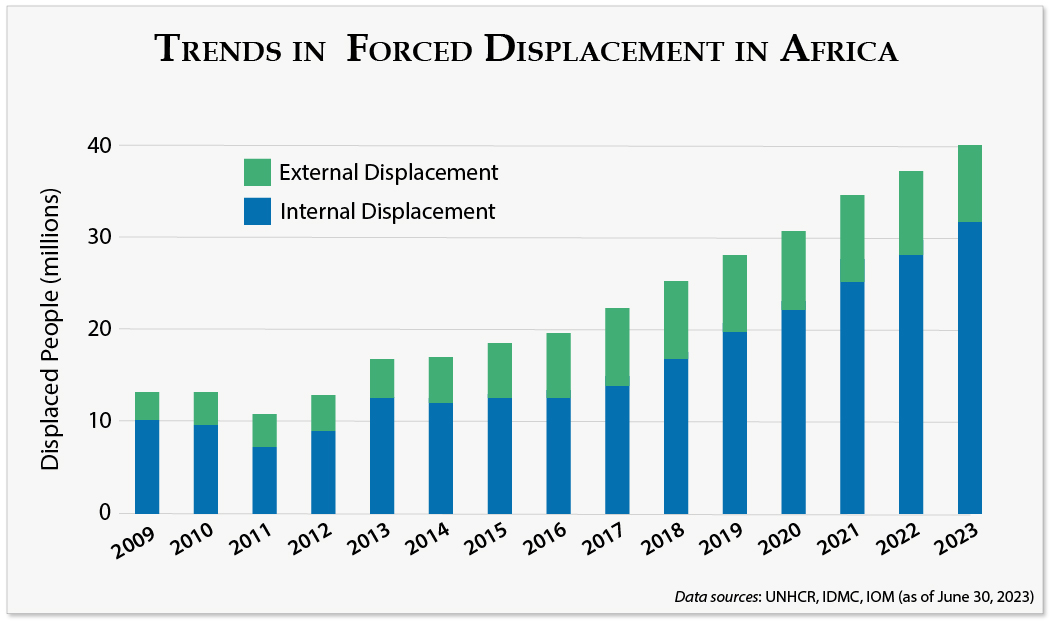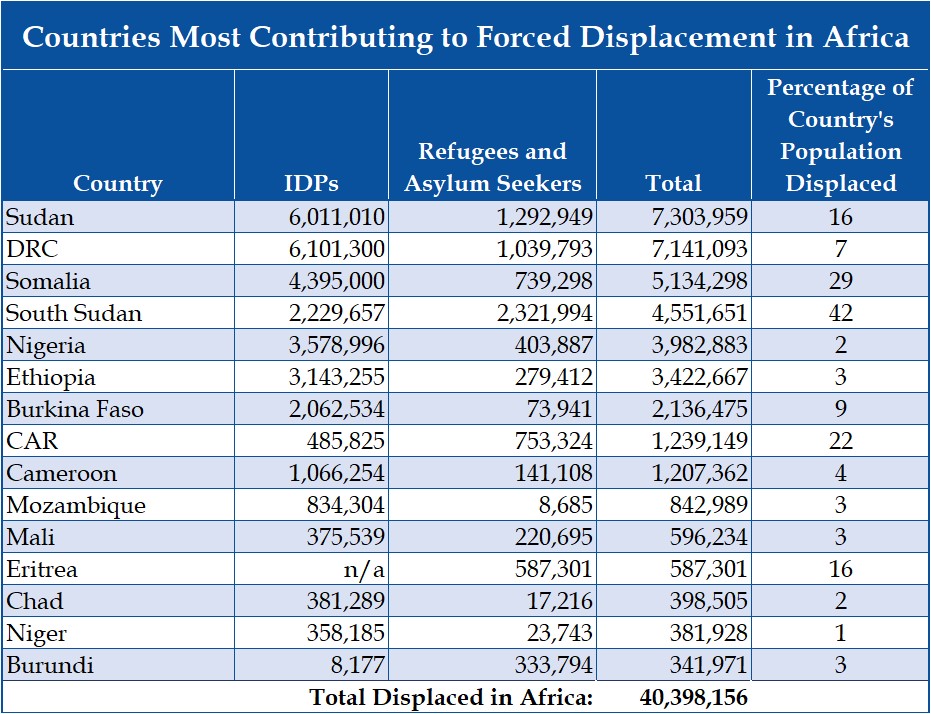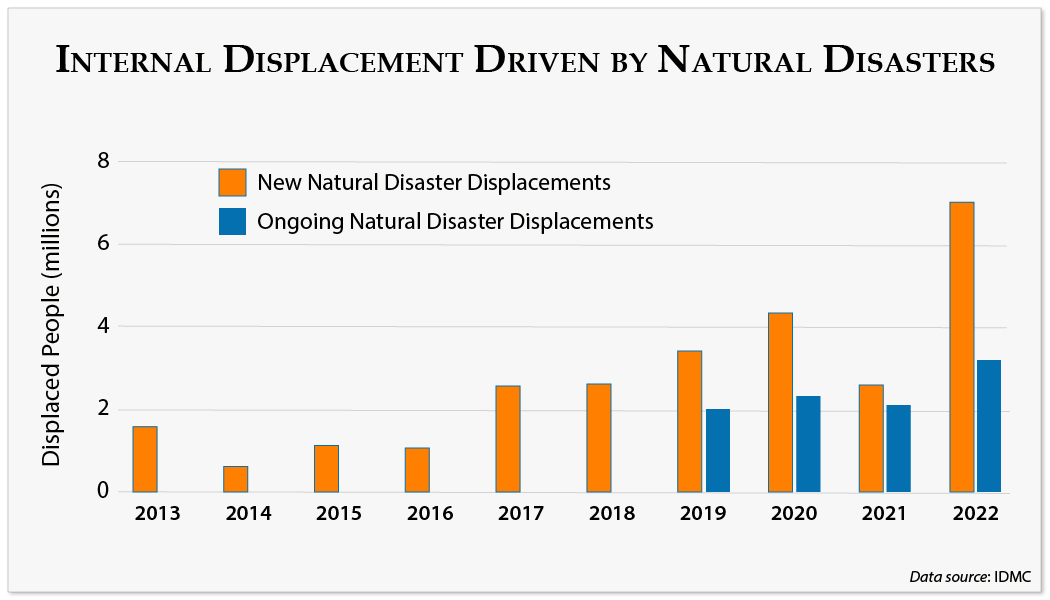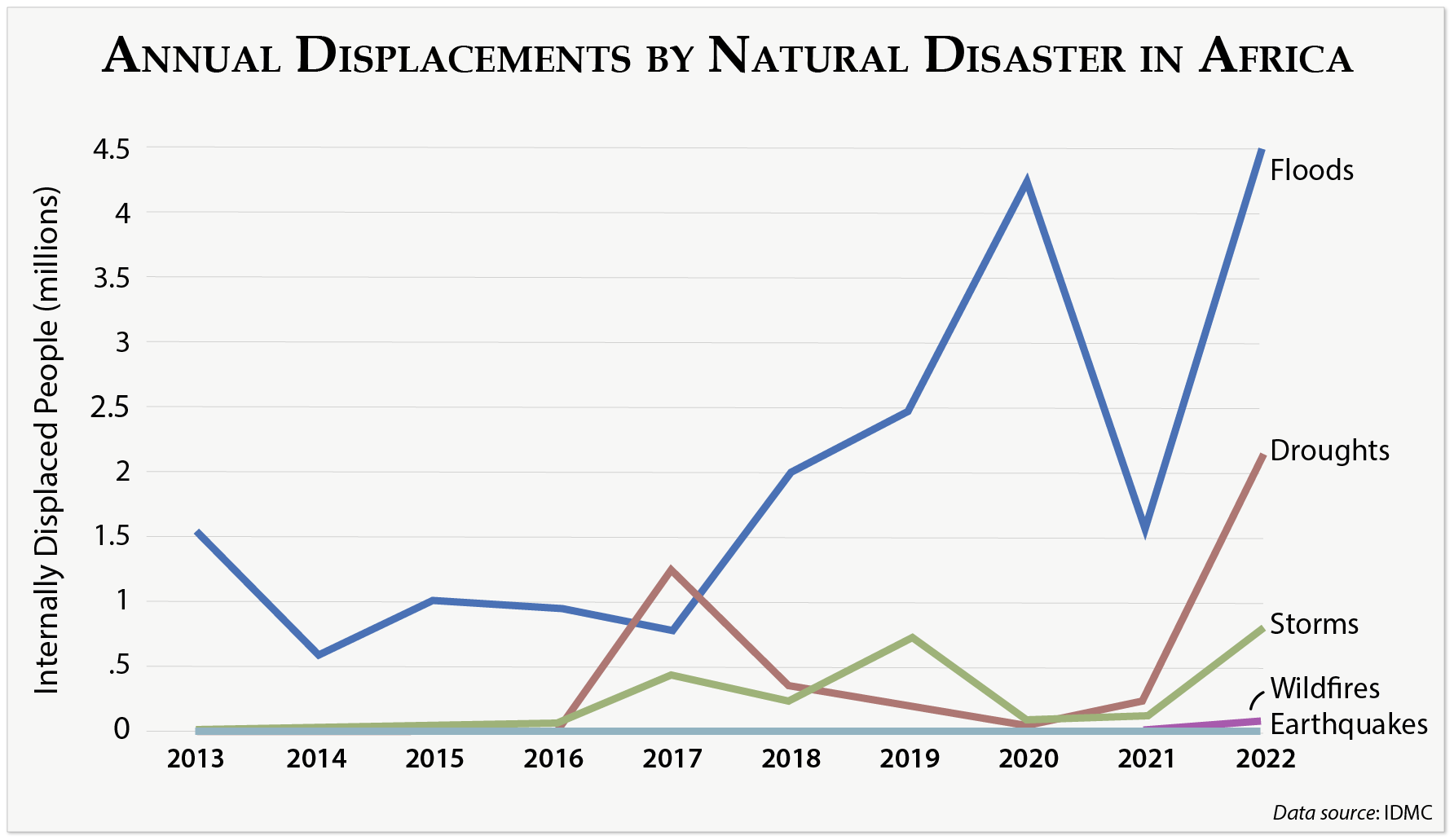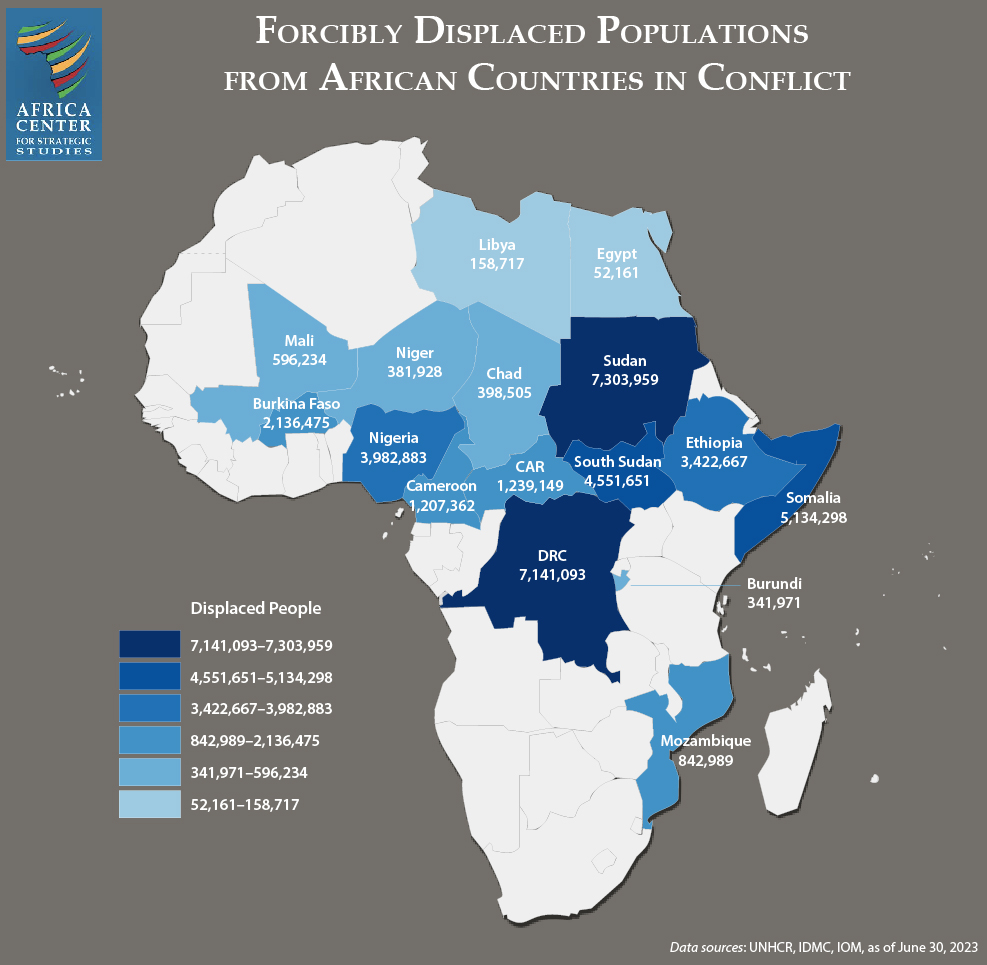
An additional 3.2 million Africans have been displaced due to conflict over the past year. This represents a 13-percent increase and continues an unchecked upward trend observed since 2011.
There are now an estimated 40.4 million forcibly displaced Africans (internally displaced persons, refugees, and asylum seekers), more than double the figure in 2016. For perspective, 40 million forcibly displaced people is more than the populations of Angola, Ghana, or Morocco.
More than 77 percent of these 40 million are internally displaced within their countries. Of those who leave their country of origin an estimated 96 percent stay in Africa. Most of those that move off the continent do so via legal channels (e.g., resettlement or education visas).
Of the 15 African countries generating the largest number of forcibly displaced people, 14 are experiencing conflict. Twelve of these 15 countries are also authoritarian leaning, underscoring that exclusive government is both a direct (via repression) and indirect (via conflict) driver of forced displacement.
Recognizing and addressing these primary drivers, therefore, is critical to alleviating the observable symptoms of record numbers of forcibly displaced people.
Many of the 16 African countries in conflict are contiguous, stretching from the western Sahel through the Horn of Africa, encompassing the Lake Chad Basin and Great Lakes regions. This is a reminder of the spillover these conflicts have on regional stability.
An illustration of this is Sudan. The clash between the army and the main paramilitary force has caused civilians to flee the violence into six neighboring countries, many of which are already grappling with their own or other rounds of regional instability.
Below, are the five countries that saw the biggest increases in the numbers of forcibly displaced people over the past year. These five are responsible for 64 percent of the forced displacement on the continent.
Sudan
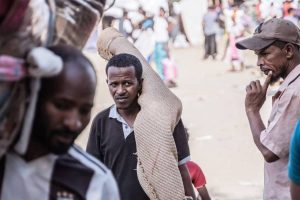
Refugees from Sudan carrying their belongings into Metema, Ethiopia, May 5, 2023.
(Photo: AFP/Amanuel Sileshi)
3.4 million increase (85% change)
7,303,959 total forcibly displaced
- The conflict between the Sudanese Armed Forces and the Rapid Support Forces has caused an estimated 4.5 million people to flee their homes. It also sparked renewed fighting (including possible ethnic cleansing) in the tumultuous Darfur region. Adding to years of instability caused by decades of military government, Sudan has now surpassed the Democratic Republic of the Congo (DRC) as the country with the largest level of forced displacement in Africa, with 7.3 million. The UN has declared that “6.3 million people [in Sudan] are one step away from famine.”
- Sudan’s neighbors, already straining under their own crises, have been saddled with absorbing those fleeing from Sudan—none more so than South Sudan. At least 182,000 South Sudanese refugees in Sudan had been forced to return to the instability in their own country, which is wracked by war and natural disasters. South Sudan is the African country with the highest percentage of its total population forcibly displaced (42%). Aid groups have warned that the returnees could overwhelm communities already struggling with interlocking crises.
Somalia
1.5 million increase (39% change)
5,134,298 total forcibly displaced
- Somalia saw a 39-percent increase in forced displacement over last year due to conflict and insecurity. This brings the total level of forced displacement to more than 5.1 million in this country of 18 million. Nearly 90 percent of the forcibly displaced (or 4.4 million) are IDPs.
- As the Somalia federal and state governments continue to lead an offensive against al Shabaab forces, the violent extremist group has doubled down on retaliatory attacks, including an increase in violence against civilians. This can be expected to further drive up levels of Somali citizen forced displacement.
- The scale of displacement in Somalia is currently even worse when environmental impacts are considered. While difficult at times to distinguish forced displacements due to conflict and natural disaster, Somalia has been experiencing the worst drought in 40 years which has caused sequential crop failures and killed millions of livestock. Accordingly, the figures above do not include the reported 787,000 Somalis internally displaced due to floods and drought.
Democratic Republic of the Congo
823,000 increase (13%)
7,141,093 total forcibly displaced
Years of ongoing multilayered conflict leading to massive population displacement has reduced the resilience of Congolese residents.
- Nearly a million people have been newly forced from their homes in the DRC in the past year as a result of violence linked to various nonstate militias, including the M23 rebel group. That puts the number of displaced Congolese at over 7.1 million, a 13-percent increase over a year ago. Approximately 86 percent are displaced internally (more than 6.1 million).
- Years of ongoing multilayered conflict leading to massive population displacement has reduced the resilience of Congolese residents. Lost homes and livelihoods, rising inflation, and insufficient humanitarian assistance have led to acute food insecurity in the DRC, affecting some 25.8 million. Most affected are the internally displaced and households hosting displaced or returned families as well as households living in areas impacted by armed conflict.
Nigeria
438,000 increase (12%)
3,982,883 total forcibly displaced
- Nigeria’s diverse security threats have contributed to an increase in 438,000 forcibly displaced people since last year. Militant Islamist group and organized criminal activity now account for almost 4 million displaced people in Nigeria’s northern states.
- In the northeastern states, the locus of the militant Islamist violence, 4.3 million people are now facing acute food insecurity, with almost half a million on the verge of famine.
Estimated Food Insecurity in West Africa
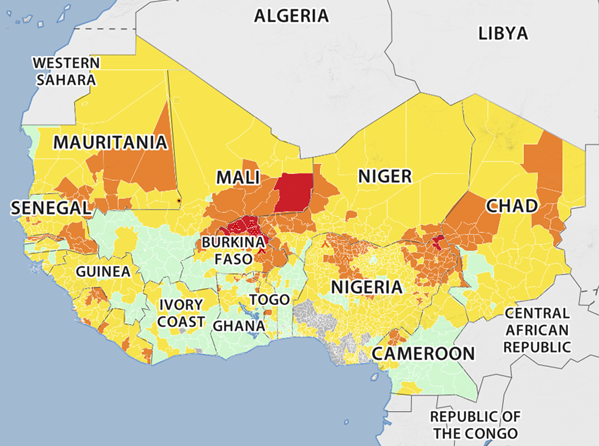
Source: Cadre Harmonisé (August 2023)
Burkina Faso
203,000 increase (11%)
2,136,475 total forcibly displaced
- More than 2.1 million people have been forcibly displaced due to escalating attacks and violence against civilians caused by militant Islamist groups. More than 20,000 are facing famine as the militants have laid siege to 20 towns, home to 800,000 people.
- Given that insecurity in Burkina Faso is largely a spillover from militant Islamist violence in Mali and that instability in Mali under the military junta continues to spiral—forced displacement in Burkina Faso is likely to increase further.
Ethiopia
1.2 million decrease (-26%)
3,422,667 total forcibly displaced.
Alongside countries showing spikes in forced displacement, Ethiopia has experienced a notable decline in the number of people displaced.
- The conflict in Tigray had displaced an estimated 1.8 million people, contributing to the record 3.9 million Ethiopians displaced at the end of 2022. With the signing of a ceasefire and the dampening of other conflicts in the country, an estimated 1.2 million Africans have returned to their communities. Due to continuing insecurity and limited access in much of Tigray, a firm figure on the number of displaced remains imprecise, however.
- Longstanding intercommunal tensions and violence built into Ethiopia’s ethnic federal model still account for more than two-thirds of the current displacement.
Climate-linked Forced Displacement is Up Too
- Over the past year, the number of people displaced due to natural disasters surged almost threefold—to 7 million. This jump follows a trend of consistently growing levels of natural disaster-related displacement in Africa since 2014.
- Historically, forced displacement due to climatic impacts has tended to be more temporary than displacement due to conflict—precisely because there is no ongoing fear of safety to oneself and family due to violence. Most everyone affected by a natural disaster was able to return home once the threat passed. This has changed in recent years. Since 2019, there has been roughly 2 million people who have been unable to return “after the storm” due to the persistence of these threats–mostly flooding, followed by drought and storms. This figure expanded to 3.2 million in 2022.
- Protracted conflict and climate crises have been causing more permanent shifts of populations from rural to urban settlements, seeking security, stability, and livelihoods. Since the infrastructural development and employment opportunities of many urban centers on the continent are not keeping ahead of these population influxes, most of these forcibly displaced are moving into informal settlements with no public services or livelihoods on the outskirts of cities and major towns.
Additional Resources
- Africa Center for Strategic Studies, “African Militant Islamist Group-Linked Fatalities at All-Time High,” Infographic, July 31, 2023.
- Africa Center for Strategic Studies, “Malian Military Junta Scuttles Security Partnerships while Militant Violence Surges,” Infographic, February 27, 2023.
- Joseph Siegle, “Intervening to Undermine Democracy in Africa: Russia’s Playbook for Influence,” Spotlight, Africa Center for Strategic Studies, February 23, 2023.
- Africa Center for Strategic Studies, “Understanding Burkina Faso’s Latest Coup,” Infographic, October 28, 2022.
- Africa Center for Strategic Studies, “Conflict Remains the Dominant Driver of Africa’s Spiraling Food Crisis,” Infographic, October 14, 2022.
- Africa Center for Strategic Studies, “Record 36 Million Africans Forcibly Displaced,” Infographic, July 19, 2022.
- Wendy Williams, “Shifting Borders: Africa’s Displacement Crisis and Its Security Implications,” Africa Center Research Paper No. 8, Africa Center for Strategic Studies, 2019.
More on: Migration and Forced Displacement


